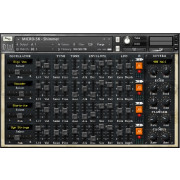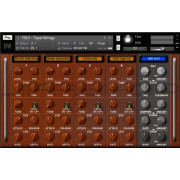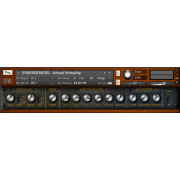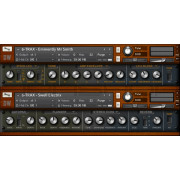You're currently on:
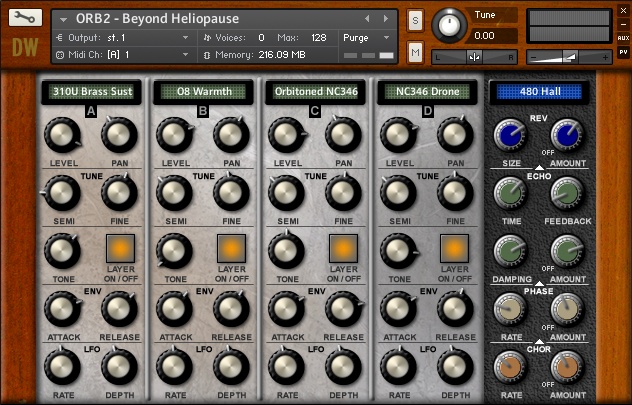
Orbitone Collection II was conceived very much as an extension to the original release of complex warm electronic textures made with unusual combinations of vintage technologies…
Featuring The Worlds Oldest String Synth That Never Was!…
The 1972 Eminent 310 Unique was a very unusual mix of combo organ and string synthesizer in its own right but what was particularly special about it was the triple parallel analog chorus processor with 6 free running clock modulating LFOs better known as the Orbitone. It is this complex multi-path analog effect that makes the famous strings on the 310U so very special and slightly simplified technology was later used to good effect in the Solina and ARP Omni string synthesizers. It was originally developed to effectively make one rank of sawtooths become three with a high degree of movement without resorting to the very significant expense and complexity of three full divide down chains with independent master oscillators.
Being a self confessed boffin it suddenly occurred to me one day that I had a fantastically rare opportunity on my hands to attempt to feed 1938 Novachord 346 through the Orbitone stages on the Eminent. After consulting the 310U’s sea of schematics for some time I determined a potentially suitable point to inject an external audio signal. To my delight this resulted in quite simply some of the most organic synth strings I’ve ever heard..
All those lumps bumps and imperfections are thrown into a rich soup of analog processing and the result is truly delicious!
Now armed with this monstrous analog effects processor I got curious and fed a number of other sources through it including one instrument that is known to be a little weedy in isolation namely the little CS-01 monosynth. As well as the Novachord I sampled offerings from new patches I dialled up via the 310U Orbitone stages from the Juno-106, CS-01, Crumar Bit One and Omega 8. In addition to this some new sampled material was taken from the instruments via an analog chorus unit including a series of brass and guitar timbres. Some of the guitar sounds were also created by passing Minimoog 7751 and the Bit One through a 1960’s Echo-Reverb featuring a tube buffered electrostatic Tel-ray “Oil Can” delay unit. A further resonator choir was made by feeding the Juno-106 through the rehoused Polymoog Formant Resonator. In addition, a combination of organ stops were sampled directly from the Eminent and a further harpsichord patch was dialled into Polymoog 203A 3211 courtesy of Will Gregory of the electronic music duo Goldfrapp.
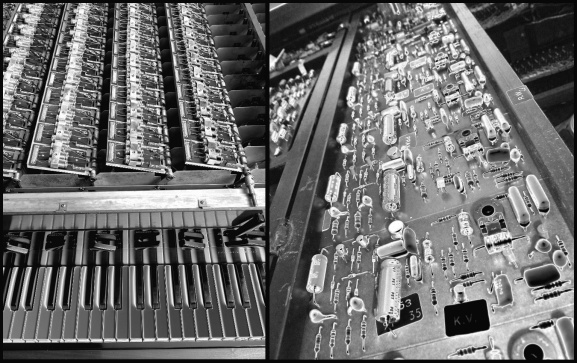
Orbitone Collection II utilises the same proven 4-voice layering engine as the original release but operating on a brand new sample set constructed using a different combination of source instruments and techniques.
Combined Libraries…
As well as the new library featuring 40 example patches and 40 layered multis, a further 40 combined layers have been created that combine patches from both libraries together to form new layered instruments and textures. The new sounds have been presented as a merged installation thus permitting the user to access and walk through patches from both libraries as one.
*Equipment Used: 1972 Eminent 310U, 1976 Minimoog, 1938 Novachord, rehoused 1978 Polymoog Formant Resonator Section, 1960’s Echo-Reverb tube “Oil Can” Delay, Polymoog 3211, Juno-106, Crumar Bit One, Studio Electronics Omega 8, CE-300 chorus, CS-01.
The Orbitone Collection requires Kontakt version 4.2.2 or higher.
“GREAT JOB!! I love these new old sounds. Wobbly, retro, noisy as hell in some
cases, worn, distressed, evocative of a bakelite world…
Death to the Giant Silver Workstation…
Just great programming from an enviable source library. Unique. Saliva-
prompting. Above all a profoundly musical collection of refreshingly
flawed tones.”
Harvey Jones, Synth player with Sex and Sorrow, Nadia Ackerman, and Blow Up Hollywood.
Download Contents
- The Orbitone Collection I & II consisting of 607 generously long 24-bit samples
- 4-Voice Layering Engine with ability to save user patches
- 48 multi-sampled instruments acting as voices/partials in the layering engine
- 80 editable example instrument patches (in .nki format)
- 40 editable example layered multis (20 combining Orbitone II and 20 combining both libraries)
- User Manual
System Requirements
- Both Orbitone Collections require Kontakt version 4.2.4 or higher
- Around 1GB Free Hard Disk Space for the combined library

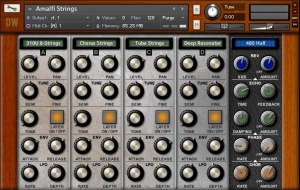
A selection of complex warm electronic textures made with an unusual combination of 1972 Eminent 310U, a rehoused 1978 Polymoog Resonator Section, 1976 Minimoog Model D and 1938 Novachord all processed with vintage classic analog and tube technology and brought together in the same proven 4-voice layering engine as the S-VX library….
Please Note: The Orbitone Collection has since merged with Orbitone II as a combined product.
“First, the Noble Horns would make any soundtrack maker very happy. It has exactly the right blend of “almost acoustic” and “ageless” and “epicness”. I really, really dig the “grrraaaawwwwrr” of the sound. Amalfi Strings… yum. I think you’re at something that speaks to me in the exact right words. I cannot describe it better.” Petri Alanko, Game & Film Score Composer (Xbox 360 game, Alan Wake)
“Listened to the demo, concluded it was a bloody lovely sound library and bought it on the spot. Great bargain! I think it’s a lovely set of sounds. Really. Right in the zone for the work I am trying to do. Gorgeous. You have a very good ear.” tropicalontour, KVR Forum
“Dan, I saw your website on Rekkerd.org recently and checked out your demos. I got thru the first Orbitone example and immediately bought both of your sample sets. From earthy to epic, it’s all there. What really impresses me is the warmth of the samples. I’ve had some real fun combining both the Orbitone and S-VX Hybrid patches. I think the best thing that can be said of your sample sets is that it inspires me to make music! Great work!!! Keep them coming!” Rick G.
Download Contents
- The Orbitone Collection consisting of 226 generously long 24-bit samples
- 28 multi-sampled instruments acting as voices/partials in the layering engine
- 4-Voice Layering Engine with ability to save user patches
- 40 editable example instrument patches (in .nki format)
- User Manual
System Requirements
- The Orbitone Collection requires Kontakt version 4.2.4 or higher
- Around 500Mb Free Hard Disk Space
Equipment Used
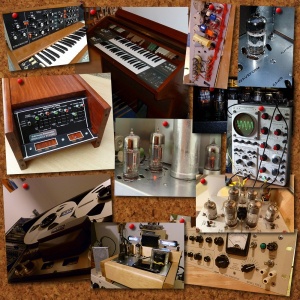
1972 Eminent 310U (strings, pads, resonator choir, e-piano, organ), 1976 Minimoog (brass, pads, bells, chimes), 1938 Novachord (strings, e-piano), rehoused 1978 Polymoog Formant Resonator Section (choir), 1976 Revox G36 tube half track tape machine (g36 choir), Panoramic tube Dual Tone Generator (chimes, e-piano), two 1967 Heathkit EUW-27 tube signal generators (chimes, e-piano), ARP Omni Chorus section (strings), Hideaway Studio Triple Tube Hybrid Phaser (evolving pads, phased chimes) and Dual Tube Hybrid Filter (underwurlde sweep), Tube Ring Modulator (bell ratios), Discrete Dual Exponential Sawtooth Generator (french horns), Tube Overdrive and Passive Triple L/C Resonator buffered with Y-amplifiers from a 1968 Tektronix tube scope! (deep resonator vox), All sound sources captured via two Hideaway Studio Type TEQ-9B Active Tube EQs in 24-bits with the RME Fireface.
Warm Textures In the Making….
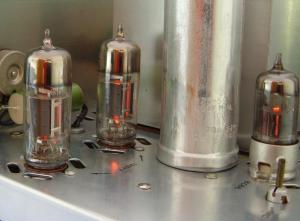
Rather than simply making yet another virtual instrument, the arrival of a recently restored 310U was the perfect excuse to bring together a taster of a number of combined sound sources and techniques I’ve been working on to create rich, warm and complex textures. In particular I’ve fallen in love with the sheer musicality and magic of tube oscillators and wave shaping coupled with rediscovering classic analog synthesis and effects.
This has formed the basis of a new follow on to the recently released S-VX library and created very much with the idea of the two libraries being used in tandem to offer a very significant degree of opportunity for layering and blending new sounds.
The Orbitone Collection features the same proven 4-voice layering engine but operating on a brand new sample set made using a very different set of techniques to S-VX but with the similar timbres and textures in mind.
Like S-VX, Minimoog 7751 was both sampled directly and also washed through the Triple Tube Hybrid Phaser to form a number of looped textures with movement. Similarly, although the 310U was sampled in isolation, it was also passed through the rehoused resonator section of a Polymoog to magically turn brass formants into a choir!
Several tube wave shaping circuits, an L/C resonator based on the Novachord and vintage signal generators were utilised to produce deep vocal formant drones. The Tube Strings and were a blend of Novachord, ARP Omni and Discrete Tube Synthesis. The e-Piano was created by layering piano like timbres from the Novachord, the 310U and three tube oscillators mixed and tube wave shaped.
The Arrival of 91-0071750…
Over the past few months a dedicated chap from Holland called Albert Steenbergen has been doing a wonderful restoration job for me painstakingly cleaning and recapping a monster. Albert is best known for keeping Jean Michel Jarre’s infamous fleet of 310’s alive and well for use on tour and simply must win the title of World’s Best and Most Patient 310U Guru!
The beast recently safely arrived in the UK in a large crate in the pouring rain which resulted in a manic struggle with a friend to drag her inside through a hastily unhinged doorway – disaster narrowly averted when the 240lb crate very nearly toppled over backwards off the door ledge!
Some Background on the Eminent 310U

The Eminent 310 “Unique” is largely considered to feature the world’s first commercial string synthesizer section (although that title really ought to go to Laurens Hammond’s incredible 1938 Novachord!).
The 310U was designed and manufactured in Holland by Eminent and released in 1972. This boldly unusual combination of electronic organ and polyphonic synthesizer probably would have probably slipped into historical oblivion if it wasn’t for Jean Michel Jarre discovering its potential and using it to great effect in 1976 on his hugely successful and pioneering album, Oxygene. Although this is common knowledge, what is less understood is that far more than simply the infamous string section was put to use in the making of this landmark release.
Although the instrument itself didn’t become hugely popular outside of Holland, Eminent licensed out their string synth technology to ARP to become the successful Solina and Omni range. The 310U boasts really quite an unusual architecture permitting a mixture of sustained and percussive envelopes to be applied to combinations of all of the timbres which can be layered together. There is also a gorgeous swirly six-stage analog stereo chorus “Orbitone” section and built in spring reverb. The instrument was significantly more complex than most combo organs of the era due to in the main to the polyphonic percussive and sustain controls using discrete analog technology throughout.
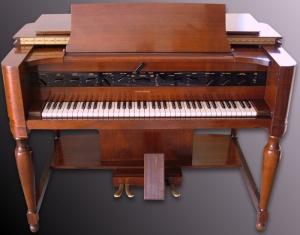
In fact, having studied the workings of both instruments in detail, I’d have to say the 310U is in many ways the closest successor in ethos, character and architecture to the 1938 Novachord and marks an historically important crossover between electronic organ and polyphonic synthesizer technologies.















